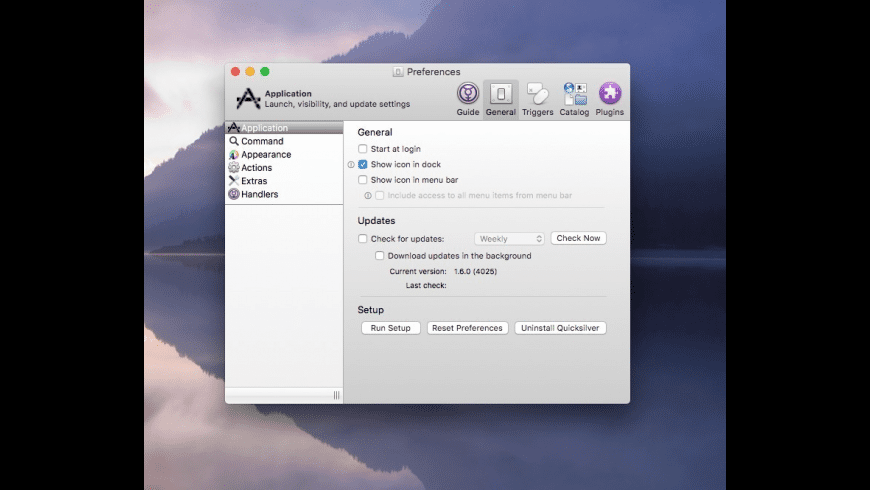Quicksilver, the donation-ware utility app that aims to speed up a wide range of the things you do on your Mac, has finally made it out of beta—some 10 years after it was first made available. The app is compatible with OS X 10.6 onward.
- Quicksilver 1 0 – Application Launcher And Much More Money
- Application Launcher Software
- Quicksilver 1 0 – Application Launcher And Much More Free
Amazon Music Stream millions of songs: Amazon Advertising Find, attract, and engage customers: Amazon Drive Cloud storage from Amazon: 6pm Score deals on fashion brands. Quicksilver is a launcher utility app for Mac OS X which gives you the ability to perform common, every-day tasks rapidly and without thought. An introduction to Quicksilver's abilities include: Accessing applications, documents, contacts, music and much, much more.
Quicksilver is best thought of as auto-complete for the Finder. Just as Google will suggest auto-completions when you start to type a search-term, Quicksilver also aims to predict what you are trying to do and offer shortcuts. There are also plugins for many apps that offer the same benefits within an app.
Although Spotlight does some of the same things, Quicksilver is much more flexible and personalized. For example, if you type PS, it might open Photoshop, as that's something you do a lot. If someone else types PS, it might start an email to Phil Smith…
I should make this a regular feature, where I take an application in OS X and point out its nearest Linux equivalent. Kind of like, 'I used to do that s___ in OS X. Now I got Linux. How do I do that?'First up is Quicksilver. If you don't know, Quicksilver is an OS X application launcher and much more. It basically allows you to open any application, document, or task using only the keyboard. It has a learning curve, but once you get the hang of it, it greatly speeds up your workflow.
There are two Linux alternatives I'll write about today, Kupfer and Synapse. Ubuntu's Unity and the new Gnome Shell have a similar feature built-in, but there's no reason those of us running Openbox or some other lightweight environment have to do without the snazzy features of a modern desktop. And Kupfer gets things off to a good start.
It's immediately familiar to Quicksilver users, and with its array of plug-ins pre-installed, comes with a lot of functionality out of the box. You invoke it with ctrl + spacebar or clicking on it in your system tray and then start typing and tabbing and arrow-keying. It's pretty intuitive. It has a fairly light memory footprint and a helpful preferences section where you can choose auto-load on login without having to edit config files. Imagine that.

Synapse is slightly different. It has a similar interface and comes with different skins, but it comes with less plug-ins built in and less functionality out of the box. Instead, it uses the Zeitgeist backend. Zeitgeist basically logs all your recent activity and how often you do certain tasks, and with Synapse utilizing it, can anticipate what you want almost before you type. Once you train it, Synapse just might be the more powerful in the long run. It's also fairly lightweight and has a similar preference panel where you can choose auto-launch on login instead of editing config files. Imagine that.
If they're both invoked with ctrl + spacebar, make sure they're not both set to auto-launch, though.
The only glitch I found (on both) was with drop shadows causing artifacts after the popup windows closed. I fixed it by adding f and -D1 options to my xcompmgr settings like this:

Synapse is slightly different. It has a similar interface and comes with different skins, but it comes with less plug-ins built in and less functionality out of the box. Instead, it uses the Zeitgeist backend. Zeitgeist basically logs all your recent activity and how often you do certain tasks, and with Synapse utilizing it, can anticipate what you want almost before you type. Once you train it, Synapse just might be the more powerful in the long run. It's also fairly lightweight and has a similar preference panel where you can choose auto-launch on login instead of editing config files. Imagine that.
If they're both invoked with ctrl + spacebar, make sure they're not both set to auto-launch, though.
The only glitch I found (on both) was with drop shadows causing artifacts after the popup windows closed. I fixed it by adding f and -D1 options to my xcompmgr settings like this:
xcompmgr -cCf -D1
